Mining lamp
 From Wikipedia - Reading time: 6 min
From Wikipedia - Reading time: 6 min

A mining lamp is a lamp, developed for the rigid necessities of underground mining operations. Most often it is worn on a hard hat in the form of a headlamp.
History
[edit]Types
1813 Dr William Reid Clanny Exhibited The Clanny Lamp
1815 Humphry Davy Exhibited The Davy Lamp
1815 George Stephenson Exhibited his Lamp
The Davey Safety Lamp was made in London by Humphry Davy. George Stephenson invented a similar lamp but Davys invention was safer due to it having a fine wire gauze that surrounded the flame. This enabled the light to pass through and reduced the risk of explosion by stopping the "firedamp" methane gas coming in contact with the flame.[1]
1840 Mathieu Mueseler Exhibited The Museler Lamp in Belgium.[2]
1859 William Clark patented the first electrical mining lamp.[3]
1870s J.B.Marsaut (France) double gauze design[4]
1872 Coal Mines Regulation Act required locked lamps under certain conditions[5]
1881 Joseph Swan exhibited his first electric lamp
1882 Made by William Reid Clanny invented a 'bonnetted' Clanny lamp,[6]
1883 Elliis Lever of Culcheth Hall Bowdon offered a £500 prize for creation of a safe portable mining lamp.[7][8]
1885 Thomas Evans of Aberdare made a Clanny type of safety lamp[9]
1886 Royal Commission on Accidents in Mines tested lamps and made recommendations
1887 Coal Mines Regulation Act – requirements on construction, examination, where used, etc.[10]
1889 John Davis and Co, Derby, were supplying portable electric lamps[11]
1896 Coal Mines Regulation Act - requirements on provision by mine owners, where to be used, etc.[12]
1909 Cap (helmet) lamps introduced in Scotland
1911 Prize offered for best electrical lamp
1911 Coal Mines Act made requirements for pit managers to take examinations, where can be used (including electrical), etc.
1920 Electrical lamp with built in accumulator
1924 Miners Lamp Committee – tests and recommendations
1950 Shale miner's electric safety cap lamp and battery pack made in England and supplied by Concordia Electric Safety Lamp Company Ltd, Cardiff.[13]
Variants
[edit]- Carbide lamp, a lamp that produces and burns acetylene
- Safety lamp, any of several types of lamp which are designed to be safe to use in coal mines
- Davy lamp, a safety lamp containing a candle
- Geordie lamp, a safety lamp
- Wheat lamp
See also
[edit]References
[edit]- ^ "Davy Safety lamp | Science Museum Group Collection". collection.sciencemuseumgroup.org.uk. Retrieved 2023-02-13.
- ^ "Miners 'Mueseler' safety lamp". collection.maas.museum. Retrieved 2023-02-13.
- ^ "Hungerford Arcade Digging Deep (A History of Miners Lamps)". Hungerford Arcade. Retrieved 2023-02-13.
- ^ "Resource Guides – The Mining Institute". Retrieved 2023-02-13.
- ^ "Coal Mines Regulation Act (1872) Amendment Bill—Bill 108". UK Parliament.
- ^ "A 'bonnetted' Clanny lamp, no. 19, c. 1882. | Science Museum Group Collection". collection.sciencemuseumgroup.org.uk. Retrieved 2023-02-13.
- ^ Britain), Royal Society of Arts (Great (1883). Journal of the Royal Society of Arts. Society of Arts.
- ^ Wales, Giftware. "History of the Miners Lamp". Giftware Wales. Retrieved 2023-02-13.
- ^ "Safety lamp | Science Museum Group Collection". collection.sciencemuseumgroup.org.uk. Retrieved 2023-02-13.
- ^ "1887 Act - Scottish Mining Website". www.scottishmining.co.uk. Retrieved 2023-02-13.
- ^ "DAVIS DERBY – A HISTORY OF ENGINEERING". www.asiuk.net. Retrieved 2023-02-13.
- ^ Commons, Great Britain Parliament House of (2006). Home Office. Coal Mines Regulation Act, 1896. Reports to H.M. Chief Inspector of Explosives on the Working of the Home Office Testing Station for the Years 1897 and 1898; by Major A. Cooper-Key, R.A., Her Majesty's Inspector of Explosives. House of Commons.
- ^ "Shale Miners Lamp - Scottish Shale". scottishshale.co.uk. Retrieved 2023-02-13.
- ^ "Safety lamp | Science Museum Group Collection". collection.sciencemuseumgroup.org.uk. Retrieved 2023-02-13.
- ^ "Resource Guides – The Mining Institute". Retrieved 2023-02-13.
 KSF
KSF